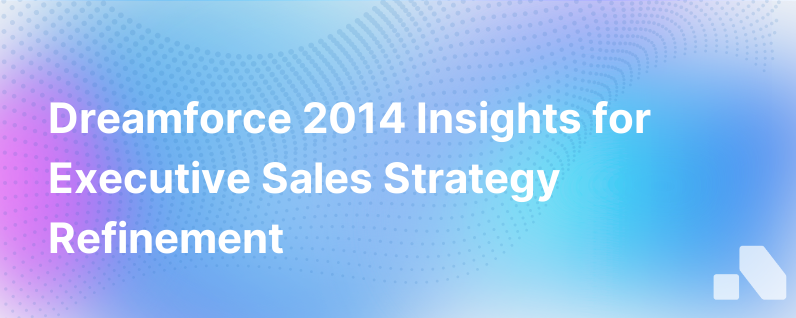
Since Dreamforce 2014, the landscape of sales, marketing, and customer engagement has evolved at a blistering pace, heavily influenced by technological advancements, changing customer expectations, and a global environment that has seen substantial shifts.
Dreamforce, Salesforce’s annual event, has always been a beacon for innovation and thought leadership in the CRM space, showcasing new products, features, and best practices. In the spirit of reflection and continuous learning, let's explore some of the war stories and learnings culled since the 2014 conference.
The Age of the Customer: Personalization and Experience
Back in 2014, the industry was already emphasizing ‘the age of the customer’, where personalized experiences weren't just valued—they were expected. Since then, this expectation has exploded, with personalization becoming a critical element of success.
Businesses have learned that personalization must go beyond simply addressing a customer by their first name in an email. It involves understanding their individual journey, preferences, and pain points. The days of generic sales pitches and broad targeting are long gone; customers now demand tailored experiences at every touchpoint.
Learning 1: Invest in Customer Intelligence
Businesses need to invest in tools and systems that aggregate and analyze customer data from various touchpoints to create a singular, actionable view of each customer. Customer Relationship Management (CRM) platforms have evolved, incorporating AI and machine learning to offer insights and predictive analytics.
Data is King, But Only if Correctly Managed
The expression 'data is the new oil' has almost become cliché, but it couldn’t be truer. Since 2014, data accumulation has grown exponentially, presenting businesses with the challenge and opportunity to leverage this data effectively. Proper management of this data has become a critical learning curve for many organizations.
It’s not just about collecting data; it’s about managing it effectively to drive actionable insights and make informed decisions. Data management practices must ensure cleanliness, organization, and accessibility—it's not merely an IT issue but a foundational business practice.
Learning 2: Embrace Data Hygiene Practices
To evade data paralysis and capitalise on the abundance of information, companies must prioritize data hygiene practices. Regular audits, clear data governance policies, and continuous training of staff in data maintenance and analysis are crucial.
The Shift to the Cloud and Mobile
Back in 2014, the industry was on the cusp of fully embracing cloud computing. Since then, cloud-based CRM solutions have become the norm, allowing for greater accessibility, scalability, and security. Alongside, the role of mobile technology has matured. No longer a secondary consideration, mobile platforms are now central to many businesses' sales, service, and marketing strategies.
Learning 3: Design with Mobile-First Attitude
Businesses learned to adopt a mobile-first attitude, considering the significant amount of web traffic and interactions that now come from mobile devices. Making sales and customer service tools accessible and optimized for mobile is not optional—it’s mandatory for a responsive, contemporary business.
The Digital Transformation is Continuous
One of the key learnings since Dreamforce 2014 is that digital transformation isn't a one-time project—it's a continuous process. Technologies that were emerging in 2014, like AI and IoT, are now everyday tools that shape how we interact with data, machines, and even each other.
Learning 4: Commit to Continuous Learning and Adaptation
Businesses have to foster cultures of continuous learning and adaptation—embedding in their ethos the understanding that digital transformation is perpetual. Through iterative improvements, regular training, and a mindset that anticipates change, companies can stay relevant and competitive.
The Emergence of AI and Automation
AI and automation have gained significant mindshare since 2014, presenting new opportunities and challenges. On one hand, these technologies have provided remarkable efficiency gains and customer insights. On the other, they have led to heightened customer expectations and concerns over the loss of the 'human touch'.
Learning 5: Striking the Balance Between AI and Human Interaction
Businesses are learning to strike a balance between the efficiency of automation and the intuitiveness and empathy of human interaction. It's about leveraging AI to handle mundane tasks and surface key insights while empowering human teams to tackle complex, sensitive, and creative tasks that AI can't handle.
Conclusion
The post-Dreamforce 2014 era has been characterized by several dramatic shifts, not the least of which has been accelerated by the unprecedented global pandemic. We've witnessed the continued rise of the subscription economy, an even greater focus on sustainability, and a heightening of the virtual and augmented reality technologies in customer engagements.
What remains clear is that businesses have had to become more agile, resilient, empathetic, and technologically aware to thrive. As we look towards the future, war stories will continue to be shared, and learnings will continue to be crystallized. The goal, as ever, is to harness these insights to build better products, develop stronger relationships, and forge ahead with innovation that meets the ever-evolving demands of customers and markets alike.
Salesforce and platforms like Aomni have played pivotal roles in this journey. There is excitement for what the coming years will bring, and anticipation for the ways in which companies will continue to innovate to provide exceptional customer experiences, drive sales, and build resilient, successful businesses. The journey since Dreamforce 2014 has been challenging yet enriching, and it's this process that continues to inspire and motivate businesses around the world to strive for greatness.